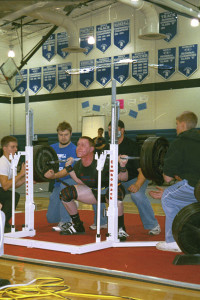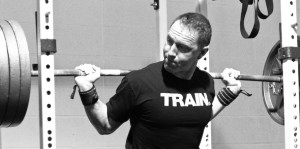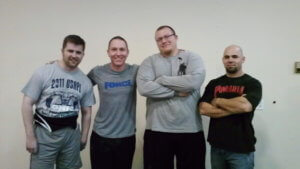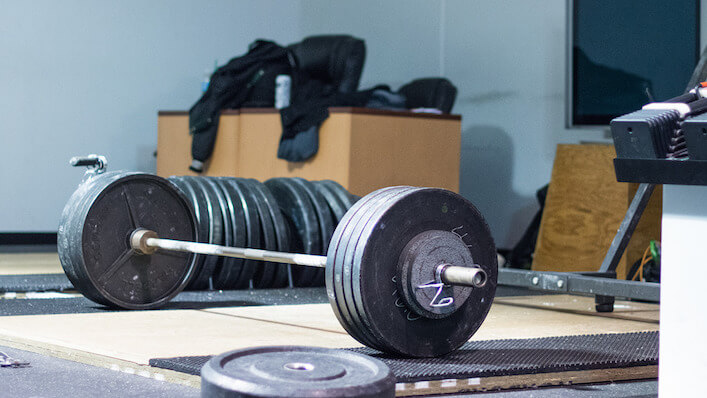(Lead photo courtesy of Lance Goyke)
In April of 2005, I was the strongest I’d ever been in my entire life.
I’d been competing in the sport of powerlifting for five years, and had just squatted 530 pounds, bench pressed 335, and deadlifted 535.
 But as the saying goes, life was a lot simpler then!
But as the saying goes, life was a lot simpler then!
For the past couple of years, my training has been hit-or-miss, to say the least.
Now keep in mind, my standards may be different from others. I’d like to think that back in the day I was pretty darn strong (by normal human standards), so my viewpoint of what “training” is is definitely skewed.
But all this got me thinking:
What was different then, versus now?
Obviously kids, two businesses, and a host of other excuses can come up, but that’s weak sauce.
That may be true, but it doesn’t answer the real question:
What things was I doing successfully back then, that I could take and apply again today?
Here’s a short list of things that I can guarantee will help fast-track your training success.
#1 – Have a Plan/Program (And Stick To It!)
When it comes to programming, we all tend to fall into three camps:
- Has a set program and sticks to it.
- Has a set program, sticks to it, but changes programs frequently.
- Doesn’t have a set program.
If you’re in Group #1, kudos! There’s a reason you’re probably successful in the gym.
However, a lot of what I run into is Groups 2 and 3.
Group 3 is simple as well: You absolutely, positively must have a program to follow.
As the saying goes, “Failing to plan is planning to fail.”
But cliches aside, it really is true.
The most successful people, in and out of the gym, always have a plan – and work that plan (okay, seriously, I’m done with cliches now).
The most difficult clients to work with fall into Camp #2.
These are the clients that want ripped abs, while weighing 280 pounds, who can squat compact cars and run down cheetahs in their spare time.
Suffice it to say, you can have it all (to some extent).
The problem is that you can’t train for everything, all at once. Adaptation doesn’t work like that.
If you want to be big, and fast, and strong, and athletic, you have to do so in a certain sequence to make sure that you cover all the bases.
So figure out what that ONE GOAL is for this program, stick to it, and then work to maintain that goal while adding layers from there.
#2 – Have A Goal (And a Deadline)
Did I mention having a goal?
No really – it’s kind of important.
The times I’ve been most successful with my training are when I’ve had a dedicated and concrete goal.
Powerlifting is an easy example. You know what your best lifts were at the last meet, and once you’ve mailed in that entry form*, it’s time to focus and dial in.
 (*Most definitely showing my age with that one.)
(*Most definitely showing my age with that one.)
The combination of having a goal combined with a deadline creates an incredible amount of urgency, which creates laser-like focus and intensity to your training.
Another example was when Pavel invited me to do the RKC certification back in 2010.
Up to that point, I had never done anything with a kettlebell in my life, outside of a couple swings here and there.
And now, within a few short months, I needed to not only be proficient technically, but to pass a snatch test where I had to throw a 24kg (53 pound) kettlebell overhead 100 times in 5 minutes?
When you have a goal and a deadline, focus is built in for you – it’s already there.
You can’t waste your time on the non-essential bullshit, because you simply don’t have time for it.
There’s only time to focus on the task at hand.
I don’t care how you do it, but find ways to create a goal with a set deadline.
You can thank me later.
#3 – Consistency is Key
Years ago, I read an article where my good friend Eric Cressey mentioned that he hadn’t missed a planned training session in eight years.
Now before you move on – stop and really about think about that for a second.
If you didn’t miss one single workout for eight years, how strong could you be?
How lean could you be?
How good would you feel about your own body?
As I think back to my powerlifting days, this was really evident in the difference between my squat and deadlift as well.
For whatever reason, I was always blessed with a pretty strong deadlift. In my first meet at 181 pounds, I deadlifted 369 pounds.
In my next meet (5 months later), I deadlifted 480.
My squat, however, languished far behind. There were many times, especially early-on, where progress was slow at best.
 Over the course of 5 years, this was my squat progression:
Over the course of 5 years, this was my squat progression:
- December 2000 – 336#
- May 2001 – 380#
- December 2001 – 407#
- April 2002 – 380#
- December 2002 – 407#
- April 2003 – 440#
- November 2003 – 474#
- May 2004 – 490#
- November 2004 – 515#
- April 2005 – 530#
As you can see, there’s no major jumps there – just slow and steady progress.
But as I alluded to above, my deadlift was at 480# in May of 2001, and only 535 four years later. What gives?
Consistency.
First off, I struggled with some lower back/SI joint issues when I deadlifted, which definitely slowed my roll.
And second, I was intensely focused on the squat. I hated that it was such a weak lift, and I focused all my time and energy into bringing it up.
I’m a big believer in the Slight Edge Principle: Regardless of how most people want to view life, things aren’t accomplished in big chunks. Instead, it’s those little, daily “Wins” that add up to what many would call “An Overnight Success.”
Apply this to your training as well.
Don’t focus on the big win, or hitting home runs.
Instead, focus on putting in the work, day in and day out.
Because those little pieces of progression will definitely add up along the way!
#4 – Schedule Your Training
Looking back at the past, the times I’ve been the most successful with my training are when I’ve had a set training time/schedule.
In today’s day and age, it’s easier than ever for us to be flexible with our work and life schedule.
But I’m also a big believer that having more “freedom” when it comes to our decision-making isn’t always a good thing.
What ends up happening is that we have to make so many little decisions across the day, that we eventually succumb and stop making them all together!
Let me give you a practical example here (and yes, I realize this is ridiculous).
First and foremost, I’m very much a creature of habit at this point.
I schedule and plan my day, making sure that I’m organized and efficient the night before. This allows me to truly focus on the task at hand, and not get weighed down by “stuff” over the course of a day.
But perhaps most importantly, I don’t have to make small, conscious decisions throughout my day, which allows me to maximize both my productivity and creativity.
So what happens if I don’t do this?
Here’s a practical example:
There was a day about a month ago where I literally sat in my office for an hour, spinning my wheels and with a complete inability to focus, because I hadn’t packed my lunch and couldn’t figure out where I should go.
I’m sitting here laughing just thinking about it now, but it’s true:
Having to make too many conscious decisions throughout the day (like when we’re going to train) wears us down, to the point where we eventually stop making decisions all together.
So don’t leave it up to whim and fancy as to when you want to workout/train every day: Put it on your damn schedule!
I plan my daily schedule the night before, but the timing of it really doesn’t matter.
The day before, the week before, the month before – the mechanics don’t matter.
Put it on your schedule or calendar, just like any other appointment. This is an appointment with and for yourself.
Then all you have to do is go in and execute.
#5 – Have a Training Partner
In 2011, I got back into the sport of powerlifting.
 And honestly, if I hadn’t had my guy Little Stevie there with me to train everyday, it might never have happened.
And honestly, if I hadn’t had my guy Little Stevie there with me to train everyday, it might never have happened.
This guy was young, passionate about the sport of powerlifting, and one of (if not the best) training partners I’ve ever had in my career.
Having a training partner brings a lot of things to the table:
- Increased accountability to show up (which is probably more than half the battle),
- Improved intensity and focus during the workout (due to competition), and
- Pure and simple motivation.
On the flip side of that, a bad training partner can really slow your progress.
There’s nothing worse than having a big workout planned, but then you get that sinking feeling in your stomach when you realize your partner isn’t showing up that day!
Finding a training partner is kind of like a significant other that you don’t keep around your whole life:
Take care to find the right one, and then try to keep them around as long as you can!
Summary
For many of you, my goal wasn’t to wow you with this article – but rather, to make a point:
Many of the things that make us successful with regards to training, we already know.
It’s not about a new program, a new supplement, or some secret Soviet technique that’s going to get us where we want to go.
Instead, it’s about recommitting to the basics – the simple things that got us lean, strong and athletic initially, that we may need to get serious about again.
By recommitting to the basics, combined with a little extra wisdom that we all pick up along the way, I have no doubt you can get into fantastic shape, regardless of where you’re currently at.
Now get back in the gym and get after it!
All the best
MR

